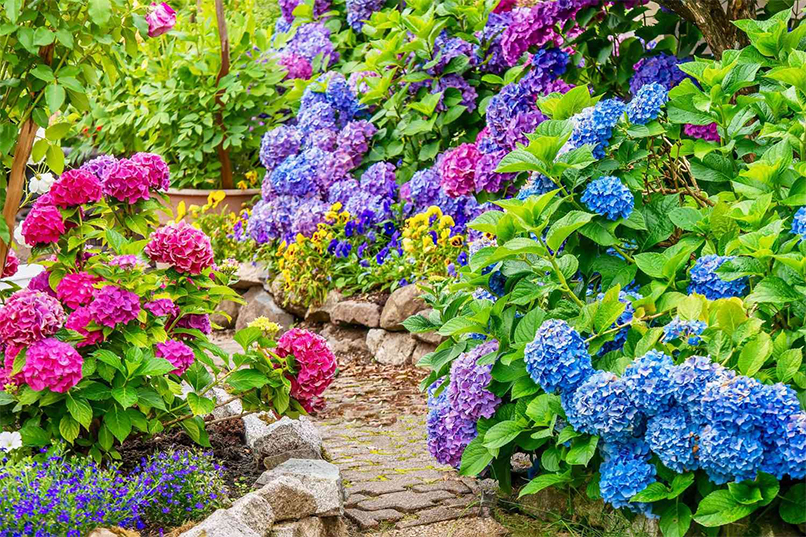Flower gardening is a delightful and rewarding hobby that provides an abundance of natural beauty to any outdoor space. Starting your flower garden can be a daunting task, but with a little planning and effort, it can be an enjoyable experience. In this article, we will cover the essentials you need to get started on your own flower garden.
Location
The first step in starting your flower garden is to choose the right location. Consider the amount of sunlight your garden will receive, the soil type, and the amount of water the plants will need. Most flowering plants require at least six hours of sunlight per day, so choose a spot that receives adequate sunlight. Also, make sure the soil is well-draining to prevent waterlogged soil that can kill the plants.

Tools and Equipment
Before starting your flower garden, you need to have the proper tools and equipment. Some essential tools include a garden trowel, gloves, a watering can or hose, and pruning shears. A garden trowel will help you dig and plant your flowers, while gloves will protect your hands from cuts, scratches, and dirt. A watering can or hose will help you water your plants effectively, and pruning shears will help you trim and shape your plants as they grow.
Soil
Soil is an essential component of any garden, and it’s essential to use high-quality soil for your flower garden. Choose soil that is rich in nutrients and organic matter to help your plants thrive. You can amend your soil by adding compost, which will improve soil texture, drainage, and fertility.
Plants
Choosing the right plants for your flower garden is crucial. Consider the size and shape of your garden, the amount of sunlight and water the plants need, and the colors and textures you want to incorporate. Some popular flowering plants include roses, lilies, daffodils, tulips, and hydrangeas. Make sure to select plants that are suited for your climate and soil type.
Mulch
Mulch is a layer of organic matter that is placed on top of the soil to help retain moisture and regulate soil temperature. It also helps to prevent weed growth and adds a decorative touch to your garden. You can use a variety of materials for mulch, such as bark, wood chips, straw, or leaves.
Fertilizer
Fertilizer provides essential nutrients that help your plants grow and thrive. There are many types of fertilizers available, including organic and synthetic options. Organic fertilizers are made from natural materials, such as compost, manure, and bone meal, while synthetic fertilizers are made from chemicals. It’s essential to choose a fertilizer that is appropriate for your plants and soil type.
Watering
Proper watering is crucial for the success of your flower garden. Most flowering plants require regular watering, but the frequency and amount of water needed may vary depending on the plant type and climate. It’s essential to water your plants deeply and consistently to promote healthy root growth and prevent water stress.

Pest Control
Pests and diseases can be a significant problem in any garden, and it’s important to take steps to prevent and control them. Some effective pest control methods include using natural predators, such as ladybugs and praying mantises, using organic pesticides, and practicing good garden hygiene, such as removing dead plants and debris.
Design
Creating a well-designed flower garden is crucial to its success. Consider the overall layout of your garden, including the placement of plants, walkways, and borders. Choose plants that complement each other in color, texture, and height, and consider using a variety of annuals and perennials to create a garden that blooms throughout the growing season.
Sun Protection
While sunlight is essential for plant growth, it’s also important to protect yourself from harmful UV rays. Wear a hat, sunglasses, and sunscreen when working in your garden, and consider creating a shaded area where you can take breaks and enjoy the beauty of your garden.
Maintenance
Maintaining your flower garden is crucial to keeping it healthy and beautiful. Regular tasks include watering, fertilizing, pruning, deadheading, and removing weeds. You should also monitor your plants for signs of disease and pest infestations and take action as necessary to prevent further damage.
Patience
Creating a beautiful flower garden takes time and patience. Don’t expect instant results, and be prepared to learn from your mistakes. Gardening is a process of trial and error, and it’s important to approach it with a sense of curiosity and openness.
Support
Gardening can be a solitary activity, but it’s also a great way to connect with others who share your passion for plants and nature. Consider joining a gardening club or attending local workshops and events to connect with other gardeners and learn new skills.

Sustainability
Finally, it’s important to practice sustainable gardening practices that help preserve the environment and promote biodiversity. Consider using organic fertilizers and pesticides, planting native species, and creating habitats for beneficial insects and wildlife.
Budget
Before starting your flower garden, it’s important to establish a budget. Gardening can be an expensive hobby, so determine how much you’re willing to spend on plants, tools, and other materials. Consider shopping for plants and materials during sales and off-seasons to save money.
Research
Research is an essential aspect of starting a flower garden. Before choosing plants, learn about their growing conditions, soil requirements, and potential pests and diseases. Research gardening techniques and best practices to help your plants thrive.
Companions
Companion planting is the practice of planting certain plants together to improve growth and deter pests. Some plants, such as marigolds and lavender, are known to repel insects, while others, such as beans and peas, can fix nitrogen in the soil. Consider incorporating companion plants into your garden design.
Garden Structures
Garden structures such as trellises, arbors, and fences can add structure and height to your flower garden. They also provide support for climbing plants such as roses and clematis.
Containers
Container gardening is a great option for those with limited space or poor soil quality. Choose containers that are large enough for your plants to grow and have adequate drainage. Consider using decorative pots or repurposed items such as buckets and crates.
Garden Journal
Keeping a garden journal is a great way to track your progress and learn from your successes and failures. Record planting dates, plant varieties, and any issues or successes you encounter. You can also use your journal to plan future plantings and garden designs.
Starting a flower garden can be a challenging and rewarding experience. By considering these tips and putting in the effort, you can create a beautiful and thriving garden that provides you with enjoyment and satisfaction for years to come. Remember to be patient, seek support and advice from other gardeners, and enjoy the process of creating a space of natural beauty and tranquility.







